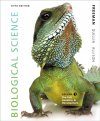Textbook
Out of Print
By: Scott Freeman(Author), Kim Quillin(Author), Lizabeth A Allison(Author)
672 pages, illustrations, colour tables
![Biological Science, Volume 1 Biological Science, Volume 1]()
Click to have a closer look
About this book
Contents
Biography
Related titles
About this book
Supports and motivates you as you learn to think scientifically and use the skills of a biologist. Scott Freeman's Biological Science is beloved for its Socratic narrative style, its emphasis on experimental evidence, and its dedication to active learning. In the Fifth Edition, the author team has expanded to include new members-bringing a fresh focus on accuracy and currency, and multiplying the dedication to active learning by six. Research indicates that true mastery of content requires a move away from memorization towards active engagement with the material in a focused, personal way. Biological Science is the first introductory biology text designed to equip you with a strategy to accurately assess your level of understanding, predict your performance, and identify the types of cognitive skills that need improvement.
Contents
1. Biology and the Tree of Life
2. Water and Carbon: The Chemical Basis of Life
3. Protein Structure and Function
4. Nucleic Acids and the RNA World
5. An Introduction to Carbohydrates
6. Lipids, Membranes, and the First Cells
7. Inside the Cell
8. Cell-Cell Interactions
9. Cellular Respiration and Fermentation
10. Photosynthesis
11. The Cell Cycle
12. Meiosis
13. Mendel and the Gene
14. DNA and the Gene: Synthesis and Repair
15. How Genes Work
16. Transcription, RNA Processing, and Translation
17. Control of Gene Expression in Bacteria
18. Control of Gene Expression in Eukaryotes
19. Analyzing and Engineering Genes
20. Genomics
21. Principles of Development
22. An Introduction to Animal Development
23. An Introduction to Plant Development
Customer Reviews
Biography
Scott Freeman received his Ph.D. in Zoology from the University of Washington and was subsequently awarded an Alfred P. Sloan Postdoctoral Fellowship in Molecular Evolution at Princeton University. His current research focuses on the scholarship of teaching and learning and he recently published two papers on his work: (1) how active learning and peer teaching techniques increase student learning and improve performance in introductory biology (Freeman, S., E. O'Connor, J.W. Parks, M. Cunningham, D. Hurley, D. Haak, C. Dirks, and M.P. Wenderoth. 2007. Prescribed active learning increases performance in introductory biology. CBE-Life Sciences Education 6: 132-139.); and (2) how the levels of exam questions vary among introductory biology courses, standardized post-graduate entrance exams, and professional school courses (Zheng, A.Y., J.K. Lawhorn, T. Lumley, and S. Freeman. 2007. Applications of Bloom's Taxonomy Debunks the "MCAT Myth." Science, 25 January 2008: 414-415).
Kim Quillin, combines expertise in biology and information design to create lucid visual representations of biological principles. She received her B.A. in Biology at Oberlin College and her Ph.D. in Integrative Biology from the University of California, Berkeley (as a National Science Foundation Graduate Fellow), and has taught undergraduate biology at both schools. Students and instructors alike have praised Kim's illustration programs for Biological Science, as well as Biology: A Guide to the Natural World, by David Krogh, and Biology: Science for Life, by Colleen Belk and Virginia Borden, for their success at the visual communication of biology. Kim is a lecturer in the Department of Biological Sciences at Salisbury University.
Textbook
Out of Print
By: Scott Freeman(Author), Kim Quillin(Author), Lizabeth A Allison(Author)
672 pages, illustrations, colour tables


























